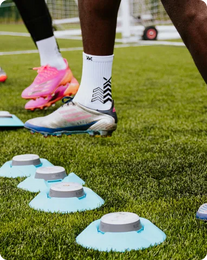Whether you are a professional athlete, a fitness enthusiast, or someone who eagerly awaits weekly team sports with friends, coming back from an injury can be a daunting process.
Questions swirl in your mind: "How soon can I start playing again? How hard should I push myself initially? When will I be ready to go full force? Should I wait until I am fully recovered before returning?" These uncertainties can be intimidating, even for top-level athletes.
However, returning to play is a gradual process that requires careful planning and patience. It’s important to understand that there are several steps involved before you can exert full force again.

This process isn’t universally the same; each individual’s journey to recovery is unique and personal, involving various factors that can affect the timeline and intensity of the return.
Elements such as a strong support system, expert guidance, and an open mindset are essential.
Keep reading to fully grasp the journey of returning to play. Learn how to embrace the process, stay patient, and before long, you’ll find yourself back in the game, stronger and more resilient than ever.
What is ‘Return to Play’?
Following an injury, ‘return to play’ refers to the gradual process of resuming performance. It’s not a single moment but a continuum requiring time, energy, and patience.
According to the First World Congress in Sports Physical Therapy, this process begins with returning to participation, where the athlete gets involved in the sport but not at full capacity.
Next is the return to sport, where the athlete plays like a regular player but not at their full performance level.
Finally, the return to performance phase occurs when the athlete reaches or surpasses their pre-injury performance level.
Studies have shown that dual training - combining cognitive and physical exercises - along with training your brain to manage stress, can help prevent further injuries when returning to play
Different Outcome Focuses on the Return to Play Process
A successful return to play is a personal and varied goal, depending on the individual.
For some, simply returning to the sport at any level is a success, especially after a severe injury. Others define success as reaching their pre-injury performance level. For many, just playing one last game is enough.
Different focuses during the return to play process reflect these individual goals and do not diminish the achievement. It's about each athlete's unique definition of success and their focus on recovery.
Goal Focus
Goal focus in terms of return to play for injured athletes involves prioritizing a quick return to the sport. This approach emphasizes a speedy recovery and getting back to competition as soon as possible.
Performance Focus
In performance-focused return to play, coaches and athletes define success by aiming for the athlete to regain their pre-injury performance level upon returning to the sport.
Outcome Focus
For doctors, a successful outcome is often defined through an outcome focus, prioritizing the prevention of new or recurring injuries. Rather than concentrating on more short-term improvements, this approach emphasizes long-term practices.
How to Prevent a ‘Removal from Sport’
Listening to your body and avoiding rushing the process is crucial to prevent setbacks or re-injury.
Instead of achieving the return to play that every injured athlete dreams of, failing to follow set outcomes, lean into the process, and take it one step at a time can result in a "removal from sport" - an inability to return to your sport.

When returning to your sport, follow this process and allow it to be slow and gradual to ensure you achieve your desired outcome.
1. Start by Incorporating Light Activity
The return to play journey starts with a gentle reintroduction to physical activity. Whether you’re an athlete, a student in after-school sports, a senior staying healthy, or a fitness enthusiast, begin with low-effort tasks.
Start by doing your weekly grocery shopping, stretching in the morning, or cleaning your home. These activities help you ease back into a routine without overexerting yourself.
2. Slowly Build Up to More Intense Working Out
The next phase involves gradually reintroducing yourself to exercise but in a minimal way. Just a few minutes a day is key. Like easing into a workout after a long break, you can’t jump back to the same weight you were lifting before. You need to gradually ease back into it and build up your strength again.

Try walking, light jogging, slow-paced bike riding, or at-home core exercises to gently teach your body to exercise again.
3. More Intense Exercise with No Contact
Now that your body has adjusted to exercising, you can begin incorporating more intense activities. This can include longer distance running, short sprints, HIIT training, and strength training. If you're a team player, you can rejoin your team and start participating in training and drills.
This is a crucial point in your recovery. As your strength returns, it can be tempting to jump back into full-throttle activities. However, avoid getting carried away and engaging in full-contact sports too soon, especially if you’re a team player or play a contact sport.
Be patient and continue following the gradual process.
4. Full Force Contact
By now, you’re almost ready to fully engage in training. The only way to prepare your body for competition is to push it during training.
If your coach is comfortable and you feel ready, this is the time to start working toward peak performance levels. Resume your regular training routine and monitor how your body reacts.
If you experience pain, take it as a sign that you may need more time in the earlier stages of the return to play process. However, if you feel that your strength has mostly or fully returned, then it’s time to get back to it.
5. Compete at Your Best Again
Get the wins you know you're capable of and prove that athletic success continues beyond injury.

Conclusion
Returning to play involves understanding the gradual process, focusing on long-term outcomes, and preventing setbacks. By prioritizing a structured recovery, taking advantage of support systems, and maintaining an open mindset, you can safely and effectively return to your sport stronger and more resilient.





















